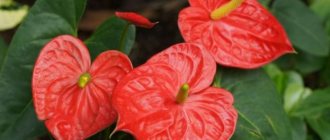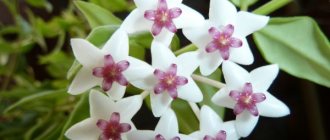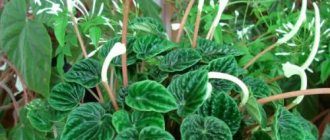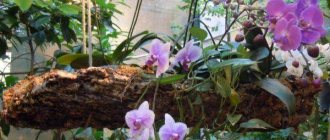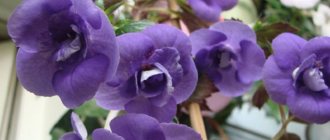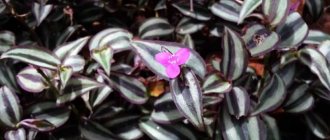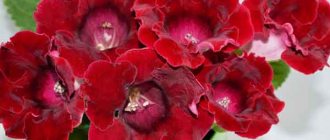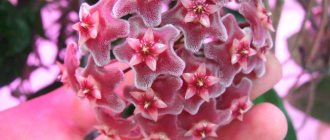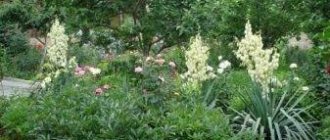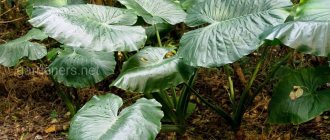On the distant shores of Australia and Polynesia, the vibrant flora is striking in its unusualness. Among the colorful kingdom, a vine with baskets of wax stars attracts attention. It owes its name to the gardener Thomas Hoya, who worked in the greenhouses with tropical flowers for the English Duke in the 19th century. Over time, it turned from a greenhouse into an ordinary green resident, which can be seen in many houses.
When a beautiful Hoya has settled in your apartment, don’t let caring for her at home scare you. This is not a capricious pet.
What does a flower look like
The purple vines bear dense, leathery leaves, occasionally covered with gray spots. As it grows, bindweed produces long, leafless shoots. They bend easily, as they grow further, new leaves appear on them and the stem becomes rigid. Housewives need to be careful not to break them.
Flower growers gave the pet a different name—wax ivy, and for this reason. When the time to bloom comes, it is covered with white umbrellas.
Constellations with a red center exude a delicate aroma. Whatever the variety of the plant, its inflorescence will always have five petals.
Another feature: during flowering, nectar ripens in the middle as a thick transparent droplet. In the wild, the liquid and smell attract insects.
Young leaves are initially shiny, becoming dull with age. Aerial roots grow on the rods, which makes the vine easy to propagate.
Varieties and types of hoya - a journey into the kingdom of flowers
Modern biologists classify about 200 varieties of this cute tropical guest. Each of them has its own characteristics, beauty, aroma and originality. And this is not surprising, because in its natural environment the flower is found in the following areas:
- Asia;
- India;
- Indonesia;
- Australia;
- Africa;
- Polynesia;
- Canary Islands.
The plant grows successfully in wet meadows near water bodies. It can be seen in open forest edges, jungles and even rocky areas. The flower gained popularity thanks to the attentive English gardener Thomas Hoya, who identified it as a separate species. As a gift, the plant received his name. Let's take a closer look at the popular types of hoya and varieties with photos, which often climb in the homes of our compatriots.
Australian
This variety of wax vine is found in Indonesia and Australia, where it was noticed by scientists around 1770. Currently, a great variety of flower varieties have been bred, which are distinguished by their uniqueness. Hoya Australis, the photo of which is presented above, is a perennial plant that lives up to 10 years of age. Its dense foliage is oval in shape, glossy and crimson in color.
Owners of this flower should prepare in advance stable supports for the massive shoots of the vine.
Inflorescences appear in the form of umbrellas consisting of many miniature buds. The maximum quantity is approximately 40 pieces. Each specimen, up to 2 cm in diameter, is painted pale white. During lush flowering, it emits a rich herbal scent. The first time buds appear on hoya is in the second or third year after planting. This period is repeated 2 times a year from the first days of summer until late autumn.
Liana does not like drastic pruning, so old or diseased leaves should be removed.
Today, many subspecies of “Australian” hoya are known. Here are some of them:
- "Trail" (has the smallest buds);
- “Forester et Liddle” (cream coloring of flowers);
- "Bailey Hill" (yellowish-round foliage, white flowers interspersed with scarlet);
- "Tonga" (large buds);
- "Pextoni" (elongated leaf plate).
The most popular subspecies is “Hoya australis lisa,” which produces buds in the shape of a five-pointed star. The petals are creamy white with a scarlet drop in the center. They exude a pleasant aroma and secrete a heady sugar nectar.
Limoniaka
This wax vine is small in size but has expressive star-shaped flowers. They are painted snow-white or pale yellow. The delicate petals are intricately curved back, and the inner crown is flattened.
The photo of Hoya Schisandra (another name for the variety) clearly shows that the central part of the bud is painted red. It grows up to 2 cm in diameter and has virtually no odor. It is crowned with a slightly pubescent peduncle that shimmers stylishly in bright light.
The leaf plates of such hoya are usually small in size: length 8 cm, width - 4. They are painted yellow-green, through which intricate veined patterns are visible. The foliage is located along the entire length of the climbing shoot, which becomes woody over the years. The plant successfully develops away from direct sunlight and under artificial lighting.
Compacta
Despite the fact that the homeland of this hoya is the majestic Himalayas, it is quite small in size. The main feature is twisted foliage with original curls. Most often dark green in color. When exposed to excessive sunlight, they fade, acquiring a yellowish tint.
Hoya Compacta blooms with soft pink stars in a spherical inflorescence. They exude a honey or coffee aroma after sunset. The minimum air temperature in the room should be at least 15 degrees. Maximum – no higher than 25 °C. Otherwise, the hoya may get sick and stop growing.
The plant loves to be sprayed with summer water and periodically pruned. As a result, a large number of young shoots appear on it.
Merilia
The flower boasts original foliage coloring. The rich green tone smoothly turns into a dark red color. At the same time, the plate is decorated with white longitudinal lines, which clearly stand out against the green-red background.
Hoya Merilii does well in small indoor plant containers. Its dense shoots are able to climb up an artificial support, which looks impressive in a home interior.
Pimentiliana
The houseplant is a fast-growing species of Hoya. A large number of green shoots adorn each adult plant. It is interesting that at the nodes it does not release aerial roots, which is common for its relatives. They can only appear when humidity levels are high.
On bare stalks, approximately 1.5 cm long, Hoya Pimentiliana produces glamorous buds. The exquisite corolla and majestic crown are painted white or yellowish. Each umbrella contains about a dozen flowers. Upon close contact, a heady aroma with sweet notes is heard.
Meredici
This exquisite hoya was first discovered on the island of Borneo (Australia) at an altitude of approximately 35 m above sea level. She grew in chalky soil and seemed to need nothing. But after some time, another botanist did not find her there. In 1999, it was spotted in Sabah and classified as Hoya Meredici.
Its beauty is manifested in large leaves, gracefully “stitched” with many dark-colored veins. Their length reaches up to 15 cm and width up to 9. Depending on the type of flower, they come in the following colors:
- light green;
- yellow-green;
- blue-green.
The shape is a leaf plate, mainly oval in nature. The edges are pointed. Its giant inflorescences in the form of yellow balls are truly a real masterpiece. They are yellow-white and cream in color, collected in loose inflorescences in the form of umbrellas. Their inner crown is always white, and the petals come in different colors. Umbrellas on hoya last for several days, so you can enjoy their beauty to your heart’s content.
Publicized
The flower has long leaves of a fleshy nature. Silver inclusions are visible on the surface of the plate. It can be oblong or oval in shape. Length – 15 cm, width – 6 cm.
During the flowering period, as shown in the photo, Hoya Publicis throws out balls or umbrellas among the dense greenery. Each of them consists of 30 buds, which are colored gray, gray-black or pink. Bright purple petals surround an ornate crown that resembles a star. This flower creates a pleasant atmosphere in the house, especially when it exudes a delicate aroma.
Hoya Greena
If you look at the variety from the outside, you can note the following features:
- Decorative curly lashes.
- The thickness of the shoots is up to 0.5 cm.
- Leathery green leaves.
- Each one has a mesh pattern of 10 pairs of veins.
- Hemispherical loose inflorescence consisting of fifty buds.
This is only a general description of "Hoya Greenii", but the flower is already a delight. It remains to add a few main points. The length of the leaf plate is about 15 cm, the width is about 4 cm. The surface is matte but smooth. Color – dark green.
The outer part of the corolla is glossy, the inner part has fine hairs. An exquisite crown of white or soft pink color rises majestically above the aureole. In the center it is painted pink. The buds remain on the plant for about 10 days, but, unfortunately, do not smell.
Denisee
Among the majestic mountains at an altitude of over 1000 m, one biologist found a wonderful plant. It wrapped a dense carpet around the centuries-old trees of the tropical forests, through which cute flowers could be seen. It was Hoya Denisi.
The leaf blades of the plant are dark green with a glamorous sheen. The main vein runs through the center, which is clearly visible, which cannot be said about the rest.
The original bell-shaped buds have a diameter of up to 2 cm. The outer part is bare, and the inner part is densely covered with delicate hairs. In general, there are up to 10 of them on one inflorescence. When the plant blooms, you don’t want to take your eyes off it.
Variegated
Its main advantage, of course, is its variegated foliage, which is located on long two-meter shoots. The unique inverted heart shape immediately attracts attention. The bright green color of the leaf blades evokes an incredible feeling of freshness in the room where such a miracle grows. In the provided photo of Variegated Hoya you can see the features of this flower.
When the vine blooms, elegantly shaped umbrellas appear on it. They consist of many snow-white, lemon or pink buds with a dark middle. Their edges are cream colored.
Variegated wax vine is a slow-growing variety, so when growing such a plant at home, you should be patient.
"Carmelae"
In the early spring of 2010, this unique flower was found on the island of Luzon. He received his name in honor of the leading specialist of the expedition - Carmela Espanola.
Hoya Carmelae is distinguished by almost round foliage approximately one and a half centimeters long. Unlike its relatives, no veins are visible on the plate. They are painted dark green.
To change the color of the leaves of a flower, you can place it in a sunny place. After some time they will acquire a crimson tint.
During the flowering period, a fluffy umbrella appears among the foliage, containing approximately 25 buds. They are often bright pink in color.
Longifolia
Another name for the variety is “Longleaf,” which calls for attention to the leaf blades. They are located in pairs along a long curly shoot. They have an oblong oval shape and a fleshy character. Length – up to 13 cm, width – approximately 2 cm. Each leaf is painted dark green. The surface is smooth. The veins are not visible. The back side of the leaf is slightly lighter than the top of the leaf.
Hoya Longifolia in its loose inflorescence contains up to 13 buds. Each of them has a white or pinkish crown topped with triangular petals. When the buds bloom, the room is filled with a persistent perfume aroma.
Thompson
In 1883, the plant was discovered high in the mountains in India. It is also found in China. They named it after the collector Thompson, who first found it.
Looking at the photo of Hoya Thompson, you can notice the dark green oval-shaped foliage. Each plate is velvety pubescent and decorated with silvery spots. On average, they grow up to 5 cm in length. The width is only 2 cm.
Compared to the foliage, the flowers seem like giants. The spherical inflorescence contains up to 30 milky buds. In the center of each there is an orange spot. The edges are topped with pointed petals in the shape of glamorous stars. During the period of lush flowering, they exude a heady jasmine aroma. Usually its presence is felt for 21 days. The peculiarity of this plant is that it begins to bloom at the end of autumn, welcoming winter with an exquisite bouquet.
"Leucorhoda"
An exquisite liana of this species is distinguished by curly thin shoots that grow quite quickly. Its graceful light green leaves are located on both sides of the stem. Their length reaches 11 cm, and their width is a maximum of 6. The shape of the foliage is in the form of an ellipse with pointed tips.
"Hoya Leucorhoda" has an original flower umbrella consisting of 10 large buds. Delicate white petals frame a pinkish crown that never changes its shape.
Since the vine grows quickly, you need to prepare a support in advance for weaving its curly shoots.
Optimist
A liana with this name can “boast” of silky foliage with a dense texture. This is achieved due to the glossy surface of the plate.
Hoya Optimistic is famous for its unusual buds. In appearance they resemble a juicy fruit in the shape of a star. Its edges are painted red, which smoothly turns into yellow. In the center of the bud, the corolla looks impressive, with a yellow frame and a ruby center.
"Sammania"
The historical homeland of this vine is the highland forests of Sumatra. It was there that it was first discovered by specialists. Hoya Sammaniana is considered a terrestrial plant, capable of growing up to five meters in height. All elements of the plant are not pubescent, but inside the shoots are filled with milk.
The leaf plate has the shape of an ellipse. The outer part is painted dark green, the lower part is slightly lighter. Some specimens have a subtle purple tint. During the flowering period, against such an exquisite background, fragrant buds in the form of bells appear. Often there are only a few of them. They are painted pale yellow with a slight greenish tint. There is a noticeable pink splash around the main calyx. Truly a wonderful masterpiece of creation.
Obowata
In its natural environment, this cute tropical flower is found in the humid forests of Indonesia, Thailand, and India. It was first recorded by biologists at the end of the 19th century. It appeared in Europe several decades later, but as a houseplant.
The Hoya Obowata depicted in the photo is a clear testament to the skill of the Great Creator, who treats people with love. This flower develops quite quickly at home. On huge shoots grow lobed leaves of light green color, along the center of which there is a wide stripe of yellow-green coloring. The additional light green foliage is distinguished by silver flecks.
When the vine begins to bloom, gorgeous two-tiered buds are formed. The main petals are slightly pointed and turned downwards. They frame a stylish flower crown that resembles a five-pointed star. At the very peak of flowering of the plant (May or June), the room is filled with a sweetish aroma. How can one not admire such beauty?
How to care for your Tropicana
She is unpretentious in everyday life, although she does not like changes in place of residence and drafts. Like all flowering inhabitants, indoor care for it consists of proper lighting, watering and timely replanting.
Once you've brought your little shoot home, find a well-lit area for it. It is advisable to place the flowerpot closer to the south window.
You should not place the pot on the windowsill. The bright sun can burn the leaves, and in winter, during the calm season, it will be damaged by the strong heat from the radiators.
Some varieties occupy a fairly large area, producing half-meter vines. There are also miniature options that do not require much space.
You can hang it like an ampel flower, or if you want, wrap the stems around the stand. The support is installed vertically or shaped like a horseshoe to create compactness. It is necessary to wrap the stems around it when they are young and flexible.
Blooming miracle
How to care for a hoya so that it pleases its owner with flowering as soon as possible? This time usually falls in the summer months, from May to September.
The secret of proper maintenance is that when brushes appear, they should not be touched, the faded umbrellas should not be cut off and replanted.
The beauty is capricious, it can drop its buds and you will have to wait a very long time for the next flowering.
Do not forget that the exotic vein spreads a strong aroma, and if they decide to move it, it will shed its flower stalks. Therefore, take care in advance about a permanent place for her.
But what to do if the gardener follows all the recommendations, but the pet does not bloom? As a rule, this period falls in the third year after rooting.
The dormant phase, like many of its flowering counterparts, occurs in winter. Then reduce watering and provide coolness. But don't overdo it. At temperatures below 12, the exotic may die.
In February-March it is time to wake him up from hibernation. Water carefully, increasing the frequency of the procedure. Spraying will not be superfluous.
To make the beauty bloom, use warm watering. To do this, place it in a deep basin or bucket, and pour lukewarm water from the shower at 35 degrees. When the water level in the container reaches the edge of the flowerpot and covers the ground, the flower is left for 1.5-2 hours.
Diseases and pests
The viability of hoya can be affected by both unfavorable living conditions and diseases:
- Roots and stems rot - excess moisture, excess fertilizer;
- leaves turn yellow - the watering regime is not followed;
- petals and buds fall off - the plant is moved to a new place, moisture gets on the inflorescences during watering or spraying;
- slow growth of stems - poor soil for nutrients, failure to comply with proportions when applying fertilizers;
- leaves become pale green - insufficient application of nitrogen fertilizers;
- brown marks on the leaves - excessive exposure to ultraviolet radiation (burns);
- Hoya leaves curl and dry - low humidity, lack of watering, high room temperature;
- does not bloom - insufficient lighting, wintering conditions are not met, flower shoots are cut off;
- deformed leaves - lack of moisture;
- brown edges of leaves - fungal infection;
- dark spots on young leaves – bacterial spot;
- leaves are covered with a white coating - powdery mildew.
Can affect mealybugs, spider mites, scale insects, and root nematodes.
Breeding in captivity
There are few ways to propagate a vine. But they are not complicated.
Propagation by cuttings involves dividing the main stem. Separate a part with two or three leaves and several nodes. Place in a jar of water, covering the top with foil to create a greenhouse effect.
If the apartment is warm, the container with the cuttings may not be covered. In two weeks, roots should appear. Don't let them grow too long, plant them in the ground right away.
Bindweed reproduces by stem layering. This is the simplest method, although it is not used often. Nodules with leaves and underdeveloped roots are visible on the lashes of the waxweed. When planting such a shoot, the plant will bloom in the year it was planted.
And another way is growing from seeds. Not every florist can wait for such planting material to appear.
The seeds are slightly dried, sown in soft soil and kept warm until sprouts appear. When they hatch, you need to be careful when watering: do not over-moisten the soil, but also do not dry it out.
Hoya fleshy
Growth:
East Asia, Pacific Islands and Australia.
Hoya fleshy is found in lowland tropical and subtropical rain forests, where it grows high in trees as a semi-epiphyte. Being a partial parasite, it penetrates with its roots into the bark of the trees on which it rests. Plant Description:
Hoya fleshy or wax ivy is a popular houseplant grown for its attractive glossy foliage and waxy flesh-colored flowers with a sweet scent. Each flower is shaped like a five-pointed star. Hoya fleshy has been cultivated for more than 200 years; many varieties have been developed that differ in leaf color.
Plant size and type:
Hoya fleshy is an evergreen epiphytic plant, a climbing shrub up to 6 meters high.
Stem:
Stems are slightly succulent, light gray, smooth, glabrous.
Leaves:
The petiole is 1–1.5 cm long. The leaf blades are wide, oval-ovate, oval or oval-elongated, 3.5–13 cm long and 3–5 cm wide, thick, fleshy, with a blunt or sharp tip, a rounded or slightly heart-shaped base.
IN THE PHOTO: The leaves of Hoya fleshy are thick, characteristic of succulents.
Peduncle:
Peduncle up to 4 cm long, hanging or somewhat erect, bears up to 30 flowers. Peduncles appear in the axils of the leaves from special spur-like outgrowths. Each season, new flowers are produced on the same spur, so it should not be damaged or removed.
Flowers:
The flowers are characteristic of the Hoya genus: small, flat, star-shaped. Each flower consists of two stars, one on top of the other. The lower star (corolla) is larger than the upper one, which is called the crown. The pedicels are reddish, pubescent, 2–4 cm long. The sepals are elongated. The corolla is 1.5–2 cm in diameter, fleshy, creamy white, but the color can vary from almost white to dark pink. The petals of the corolla are broadly ovate or triangular, with curled edges, covered inside with tiny fibers that give the petals a faint shine. The crown is white, its petals are oval-lanceolate, convex at the top. Their lower processes are sharp, the upper ones are also sharp and reddish. The flowers are very fragrant, they produce droplets of nectar hanging from each petal.
IN THE PHOTO: “Star within a star” - this is how you can briefly describe the Hoya fleshy flower.
Flowering period:
It usually blooms in early summer.
Fruits and seeds:
The fruits are spindle-shaped, 6–10 cm long and 5–15 mm. in diameter. The seeds are narrow, with a fluffy tuft.
Varieties:
Hoya carnosa cv. Krimson Queen
This variety can be identified by the white or cream border around the edges of the leaves.
Hoya carnosa cv. Krimson Princess
This variegated form is very beautiful and highly prized. It is distinguished by a green border along the edge of the leaf and a variegated center, the color of which can be white, cream, pink, yellowish or dark pink, depending on growing conditions.
Agricultural technology:
Hoya carnivore is an excellent indoor plant because it can withstand extreme heat and cold better than most other plants and does not suffer too much from lack of attention. Hoya can be guided so that its stems climb up a trellis or other support, or the plant can be allowed to twine around the windowsill. You can also grow the plant in a hanging pot. Although in nature this vine reaches a length of 6 m, in indoor conditions it grows to only 1.5–2 m, twisting around a support or hanging in picturesque cascades from hanging pots. Green-leaved varieties are hardier than variegated varieties and grow faster
Temperature:
Optimum temperature +16–30°C.
Lighting:
This Hoya prefers a well-lit place, but can tolerate less light. Outdoors, this species grows well in partial shade (diffused light or shading during the midday hours) or even shade, but indoors it needs a fairly bright place and some direct sun. Bright light stimulates flowering and the formation of more powerful leaves. But if Hoya is exposed to direct sunlight for a long time, it can get burned.
Watering:
Thanks to its succulent properties, Hoya is able to store water for a fairly long period between waterings. In summer, the plant needs to be watered regularly, but not overwatered, as it is sensitive to dampness and must dry out between waterings. The plant can easily lose its roots if they are constantly kept wet. In winter, Hoya is kept dry with good ventilation and can be watered once a month. High air humidity during the dormant period is not needed. When watering, care should be taken, as the plant tends to grow with excess water and insufficient lighting and takes on a sloppy appearance.
Fertilizer:
Hoya needs to be regularly fed with fertilizer for epiphytic plants. During the growing season, you should use a fertilizer rich in potassium and phosphorus, but poor in nitrogen, since with excess nitrogen the plant becomes soft and watery.
Substrate:
Hoya fleshy needs good drainage and a loose soil mixture that allows air to reach the roots. A typical mix would contain peat with fibrous soil and sand, plus coarse-graded drainage components such as perlite, pumice or expanded clay. Gardeners who specialize in growing Hoya often use chopped coconut shells or a good orchid mixture as a substrate. The substrate must retain moisture.
Transfer:
Hoya can be replanted at any time of the year. It is best to remove the plant from the pot a few days before repotting, then pot it in dry soil and do not water it until it begins to wilt or grow again. Hoya is replanted every two years.
Spring:
At the end of winter, when Hoya fleshy begins to grow again, it requires a lot of water, and there is no risk of rot developing due to moisture in the pot. In spring, Hoya grows well in partial shade; you can expose it to the rain.
Summer:
During the summer months, Hoya can withstand heavy rainfall, although it prefers dry weather. Outdoors, the plant can tolerate heat if it is in diffused light, this stimulates flowering. You can apply fertilizers. Moving the plant while buds are forming can cause the succulent to drop all its flowers.
Autumn:
In autumn, you can keep the plant outdoors until night temperatures drop below +10°C.
Winter:
In winter, Hoya fleshy should be kept at a temperature of +10°C, plenty of light and in a dry state, since damp, cool conditions during the dormant period lead to fungal infections. But depending on the temperature, sometimes light watering can be helpful.
Care:
Light pruning will help keep the plant tidy.
Diseases and pests:
Hoya is very susceptible to mealybugs, which attack the stems and roots of the plant, which can cause fungal infections. If the plant has dead or dying stems, you must immediately completely remove them, separate the healthy parts of the plant, dry them and root them in new soil.
Reproduction:
Hoya fleshy is easily propagated by cuttings.
Its stems form aerial roots; cuttings with such roots take root easily if placed in a moist substrate. The cuttings need to be dried during the day before planting. Another very good rooting method: you need to wrap the cut cuttings with moss and keep it moist until the roots begin to grow. The plant can be propagated by seeds, which are sown in spring in a moist substrate consisting of sand and sphagnum. The seeds are sprinkled a little. Shoots appear quickly. Editorial team LePlants.ru
Hoya varieties
In its homeland, in the tropics of Asia and on the coast of Australia, botanists count about 200 species. Only a few pieces are suitable for home cultivation.
Hoya Carnosa (Fleshy). The most common individual. In tropical forests they grow up to ten meters long. Her relatives are unpretentious; they have long settled in apartments and offices. Ball-shaped brushes of 20 flowers. Smells like honey.
The peculiarity of Multiflora (or multi-flowered) is that when it blooms, it cannot tolerate temperatures below 20 degrees and immediately drops its buds. The unusual pale yellow inflorescences resemble arrowheads and smell like lemon.
The Bella (or Beautiful) variety is not inferior in popularity to Myasistaya. Similar flower stalks, undemanding to heat and humidity. They exude a subtle scent of vanilla.
The Retuza vine is also called Dull. Suitable for growing as an ampelous species. The vines reach three meters. It has narrow leaves, completely uncharacteristic for hoya, and single flowers. Has a faint fragrance.
Kerry owes its name to the scientist who found it in Thailand. Round fluffy flowers are collected in 15-20 pieces.
The protruding red nectar gradually colors the petals from pink to purple. Because of its heart-shaped palms, this miracle of nature is called “Valentine”.
Compacta is not like its curly sisters. Its glossy leaves are twisted and clumsy, the colors are variegated, and the pale pink constellations are connected by a hemisphere. Blooms well in crowded conditions.
Locky. Its baskets are similar to multi-flowered. The difference is that closer to night its fragrance intensifies and resembles chocolate.
The variegated beauty Tricolor differs from its fellows not only in its unusual baskets, but also in its multi-colored foliage.
Linearis (or linear) is a hanging variety that came from the Himalayas. Elongated hanging batogs with needle-like leaves are crowned with bushes of white stars.
As a result of crossing two individuals, a new subspecies, Jennifer, was recently developed.
The uniqueness of the subspecies called Kurtisi is that its miniature leaves are much smaller than the inflorescences.
Hoya: types and varieties with photos
floravdome.ru > Hanging > Hoya: types and varieties with photos
Hoya is an easy-to-care indoor plant that has long been loved by gardeners. If the maintenance rules are followed, hoya grows actively and quickly and blooms with fragrant, bright flowers every year. Natural types of hoya are diverse; there are specimens with interesting shapes of leaves and flowers; in addition, breeders have created many varieties with flowers of various colors and shapes. Such diversity is interesting both to collectors and simply to lovers of indoor plants who are happy to add an interesting and beautiful plant to their windowsill. Moreover, caring for Hoya is simple - plenty of light, moderate regular watering and the correct temperature. You can read more about caring for hoya in a separate article .
The most common types of hoya are fleshy hoya and beautiful hoya . They differ in appearance and conditions of detention. Many hybrids and varieties have been bred based on Hoya fleshy. But other types of hoya also have interesting varieties.
This article describes the most popular types of this beautiful decorative vine with bright flowering in indoor floriculture.
Hoya carnosa (Hoya carnosa) is a vine exceeding 5 meters in length, requiring reliable support.
The rounded, almost oval leaves are dense, hard, with a waxy coating - they accumulate a supply of nutrients. The most common type and color of flowers is a light five-petalled star with a dark pink, also star-shaped core.
Fleshy Hoya (Hoya carnosa)
Hoya variety Krimson queen is a variegated (two-color) variety - the leaves have a light cream or pinkish color along the edge of the green leaves.
The flowers are often pink. Hoya Krimson queen
Variety Hoya Tricolor - tricolor leaves - green, cream and pink.
The flowers are scarlet. Hoya Tricolor (Hoya Tricolor)
Variety Hoya Exotica (Hoya carnosa exotica) is a fast-growing vine with fairly large (up to 10 cm) lanceolate leaves. Large inflorescences include up to 30 fragrant pink flowers with a scarlet center. There are variegated varieties with white, cream, pink spots on a green background.
Hoya Exotica (Hoya carnosa exotica)
Beautiful Hoya (Hoya bella) - unlike fleshy hoya, it is grown as an ampelous plant. The leaves are small, oval-pointed. The flowers are collected in umbellate inflorescences. Can bloom all year round.
For hoya, the temperature remains about +20o all year round.
Hoya Bella (Hoya bella)
Hoya multiflora (Hoya multiflora) - appeared in the collections of gardeners recently. The plant is often erect with bright green glossy leaves. The flowers are of an interesting shape - with narrow petals, strongly bent back, most often light in color.
Hoya multiflora (Hoya multiflora)
Majestic Hoya (Hoya imperialis) - dense large leaves up to 20 cm long on pubescent succulent shoots.
The flowers are also large (up to 8 cm), velvety, dark red with a burgundy tint and a light core, collected in umbrellas. Hoya imperialis
compacta is a miniature plant with wavy, densely growing leaves of emerald color.
There are variegated varieties. Inflorescences are spherical, round. The natural variety of Hoya fleshy is an independent ancestor of some varieties. Hoya compacta (Hoya compacta)
Hoya concave (Hoya lacunosa) - can be grown as an ampelous plant.
The leaves are small diamond-shaped. The flowers have an interesting and unusual appearance - pubescent, as if shaggy, with a bright yellow center. Hoya lacunosa (Hoya lacunosa)
kerrii - “Hoya of lovers” or “Valentine”.
Beautiful heart-shaped leaves are green or variegated. The flowers are finely pubescent, collected in dense spherical umbrellas. The flowers are yellow in color, the intensity of the color depends on the lighting and becomes more saturated with increasing amount of light. As nectar develops and accumulates, the petals change color again - from pink to deep dark red. Hoya Kerry (Hoya kerrii)
Southern Hoya (Hoya australis) is a vine with long, up to 10 meters, shoots and bright glossy leaves.
The shoots become woody over time. The inflorescences are loose, the flowers have five elongated light-colored petals and a dark pink circle under the corolla. Southern Hoya (Hoya australis)
Large-leaved Hoya (Hoya macrophila) is a very decorative variety. In addition to the beautiful, but typical for hoya flowers, it has variegated leaves, which can be of various colors - all shades of green, combinations with red, yellow, pink and with contrasting veins.
Hoya macrophylla Pot of Gold
pubicalyx is a variety with large inflorescences in red or burgundy tones.
The leaves are green with silver streaks. Hoya pubicalyx (Hoya pubicalyx) Black Dragon
obovata - round dense leaves on short petioles. The flowers are light with slightly pubescent petals.
Hoya obovata
Hoya retusa is rather an ornamental deciduous plant with inconspicuous flowering. Retusa leaves are narrow, elongated, thick leaves of a light silver-green color. It is grown as an ampel plant.
Hoya retusa
Hoya wayetii is a vine with flexible shoots and leaves with a reddish tint. The leaves are bent along the central vein. It blooms with dark purple flowers with a delicate edge.
Hoya wayetii
Share link:
Rate the article!
[Total: 7 Average: 4.7]
Fertilization and replanting
When the star's darling fades, it's time to think about replanting it. Please note: if you want it to bloom more often, place it in a tight pot.
Tropikanka needs fresh soil every 2-3 years. Before transferring, the pot should be disinfected, filled one-third with expanded clay and filled with fresh soil.
Ivy prefers to grow in a loose mixture of peat, sand and turf soil. Do not feed it immediately after transplanting. Fertilizers must be applied every ten to fifteen days. Suitable fertilizers for orchids and succulents.
Hoyas
Hoyas are sold as freshly cut or rooted cuttings. The price is indicated for freshly cut cuttings of 1 node for large-leaved varieties and cuttings of 3-4 nodes for small-leaved varieties. Hoyas can be purchased all year round, depending on the weather in the customer’s region and the method of transmission.
Hoya is a beautifully flowering evergreen vine, in which the surface of the leaf blade is as if covered with wax. For this reason it is often called wax ivy. The plant belongs to the Lastovnevye subfamily in the Kutrovye family. In total there are over 200 varieties of Khoya. In nature, they can be found in the forests of Asia, on the west coast of Australia, and in southern China. It grows in Madagascar and the Canary Islands. Can reach a length of 10 meters. At home it grows to a maximum of 5-6 meters. Different types of hoi have leaves of different sizes and are colored in different shades of green. The leaves, shiny at a young age, gradually become dull. Flowers are collected in umbrellas. Sometimes up to 50 flowers with a diameter of 0.5-2 cm are collected in one umbrella. There are varieties with large single flowers.
Caring for Hoya is quite simple, it is unpretentious and grateful for the slightest care from its owner. Perfect for landscaping apartments and offices. The optimal temperature is 20-30 °C. She loves fresh air - ventilate the room, but do not expose her to cold drafts. In winter, Hoya will withstand temperatures dropping to 15 °C, but may not survive temperatures below 10 °C. Winter maintenance at 16 -18 °C. has a beneficial effect on summer flowering. Loves bright, diffused light, but is not afraid of a little shadow. If you place it near eastern or western windows, it will not only grow well, but also bloom profusely all summer and until mid-autumn. It must be protected from direct sun. As one option, you can place the vine against the wall in the southern room.
Hoya does not like to be moved from place to place; this can cause it to drop buds and even leaves. Daylight hours should be long enough: 12-14 hours a day. To form a beautiful plant, you can use different pores: posts, trellises, trellises, arcs, rings or arches. They are necessary in order to tie numerous flexible long shoots of the plant to them. There are also bush-like varieties of Hoi that have vertical growth.
From March to October, Hoya should be watered regularly and moderately as the soil dries. It is better to use soft water. From November, watering is reduced. The plant is watered 2-3 days after the top layer of soil has dried.
Every spring it would be ideal to replant young plants into new pots 2-3 cm larger in diameter or to partially replace the soil. In a slightly cramped pot it will bloom more profusely. When replanting, you need to take this into account: either grow more young shoots, or make the hoya bloom profusely. Choose a place for it so as not to move the pot during the period of bud formation and flowering, since the plant can partially shed both buds and flowers. After flowering, long shoots should be cut off, but short and flowering shoots should be left. Do not touch the flower stalks either - after a while buds will appear on them again.
Hoya prefers loose, breathable soil, neutral or slightly acidic, where the pH does not exceed 6.5. From ready-made substrates, soil for orchids with the addition of more nutritious soil is suitable. Liquid complex fertilizers for orchids and other flowering succulents are suitable for feeding. Once every two weeks is enough, it is better to take fertilizers a little less than the norm - excess microelements will negatively affect the appearance of the flower. Immediately after planting or transplanting a plant, do not feed it for 2-3 months, provided you use nutritious soil. In winter, you should not feed the plant either.
Reproduction. The fastest and easiest way is propagation by cuttings. In order to grow Hoya, it is enough to take a cutting in 1 node (usually with a couple of leaves, and in large-leaved varieties even with 1 leaf). You can root cuttings in water or peat. The cuttings should be planted in the substrate so that the internode is covered with soil. Cover the container with the cuttings with polyethylene or other transparent material. Place in a warm, bright place. The temperature should not be below 22 degrees. After 2-3 weeks, new leaves should appear, which means rooting was successful. Keep in mind that hoya grown from cuttings will usually bloom only in the fourth year. But here everything also depends on the variety. We have indicated here general recommendations for most varieties that are most often kept at home. And the variety of hoi is so great that they are divided, like succulents, into care groups.
Don't trust grandmas!
For a long time, superstitious people have predicted bad fame for the wax plant. They called him a “runaway husband,” and warned housewives to settle him nearby. But another sign says that the green miracle protects the house from envious people, gossip and attracts wealth.
So is it possible to keep an Asian guest at home? Scientists prove that the negative impact is expressed only in the allergenic properties of pollen and nectar.
Climbing and flowering brethren decorate the house, absorb harmful substances, while ozonizing the air. In defense of the flower, we can also say that superstitions come true when you believe in them.
As you can see, caring for hoya at home is not difficult. Protect her from the cold, do not touch your star darling. But as a reward, she will give your loved ones unusual blooms and a subtle, sweet fragrance.
Caring for Hoya at home. Details
A tropical, unpretentious flower will help to revive the greenhouse, fill it with rich shades of greenery and lush flowering, and decorate the interior of the house.
Below are recommendations that will help amateur gardeners grow a beautiful plant and create the most favorable conditions for its growth, close to natural ones.
Bloom
Hoya adapts quickly at home.
This flower cannot be called rarely blooming; on the contrary, it does not skimp on the formation of inflorescences. In one season, one plant can throw out from one to fifty buds. Bright and colorful umbrellas of five-petaled flowers resembling stars can reach 8-11 cm in diameter. One bud can contain about 7-50 flowers, so it is not surprising that it can weigh more than 200 grams. Due to the formation of large diameter and weighty buds, it is not recommended to rearrange the plant during flowering.
Hoya flowers accumulate a large amount of nectar, which covers the petals. This creates the effect of covering the flowers with wax; in bright light, the blossoming buds sparkle.
Flowering lasts several months (3-4), is persistent and fragrant. A blossoming bud pleases the eye for three weeks, after which it falls off and a new one forms in its place. The emitted aroma of nectar has a sweetish aftertaste; with a large number of inflorescences, the smell can be cloying and intoxicating.
Temperature
Home hoya is heat-loving. It does not tolerate drafts and sudden changes in room temperature. Comfortable air temperature for the growth of this flower is +24°C. During the dormant period, which occurs in the winter months, Hoya is best kept in a cool place at a temperature of +10-16°C. The average temperature range is +15 - 20°C.
Despite the tropical origin of the flower and its heat-loving nature, it reacts poorly to heat. Therefore, on heat-resistant weekdays, it makes sense to protect the flower from excessively scorching sun rays, and sometimes shade it.
Watering and spraying
The active phase of growth and flowering at optimal temperature conditions should be accompanied by abundant watering of the plant.
- The regularity of soil moistening should not exceed once a week.
- The next watering is required when the top layers of planting soil are dry to a depth of 2-3 cm.
- Water the plant with settled, soft water at room temperature.
If the room temperature exceeds +24°C, the flower needs additional moisture.
- To make up for its deficiency, trays with water and household moisture sprayers are used.
- You can also help the plant cope with the lack of moisture by washing the leaves.
Please note: the foliage of a houseplant tolerates water well when sprayed and washed, and the inflorescences turn black when exposed to moisture, therefore, these hoya care procedures must be performed carefully.
Lighting
Bright diffused light favors abundant flowering of hoya, shading helps protect the foliage from burns.
Based on these characteristics of the plant, you should choose between the desire to enjoy the abundant formation of buds or juicy and large foliage. The most comfortable place in the house is the south-east side. You can grow a hanging plant in the shade, but the growth rate in this case will be significantly reduced.
In the summer, you can create natural growing conditions for the flower - take it outside and place it in a place protected from direct sunlight - near bushes or trees with a not too dense crown.
How to wipe off dust
Hoya's numerous waxy leaves are an excellent dust collector. Periodic cleaning of the foliage of this tropical beauty is mandatory. The leaves of the flower can be wiped with wet wipes made of natural fabric or washed in the shower. It is recommended to perform the procedure once a month.
Pot
Hoya flower is cultivated indoors in large and small flower pots made of plastic or clay with drainage holes.
- If the main goal when growing a flower is to bloom abundantly, you need to select a small pot. A small-sized container inhibits the development of the root system, which allows the plant to spend all the nutrients it receives on the formation of buds, and not on the development of new shoots.
- If hoya is more interesting as an evergreen climbing vine, a spacious pot (containers) is the right solution when planting and transferring the plant.
Priming
Hoya accepts breathable, lightweight substrates. To plant or transfer a flower, you can buy a ready-made mixture or prepare it yourself. When choosing, preference should be given to slightly acidic and neutral soils. The composition may vary:
- turf + leaf soil + peat + sand + humus (1/2/1/1/1);
- peat + perlite + tree bark + coconut fiber (1/1/1/1);
- garden soil + perlite + vermiculite + moss (2/1/1/1).
Feeding and fertilizer
Additional nutrients are needed only during the active phase of growth and flowering.
- Balanced mineral fertilizers (nitrogen, phosphorus, potassium, magnesium) are applied to the soil in a liquid consistency.
- The root system should not be irrigated with nutrient compositions. The prepared mixture is poured into the pot, following the edge of the rim.
- When fertilizing, you must follow the instructions of the manufacturers of fertilizers for indoor plants; experienced gardeners apply half the specified dose.
Transfer
https://www.youtube.com/watch?v=owpsCPGg8to
Hoya is replanted in the spring once every three years, if we are talking about a healthy plant. Young specimens are replanted annually. An emergency transplant is necessary for the plant in cases of infection with diseases and in case of unknown reasons for its wilting.
The transplant process consists of several steps:
- choosing a flower pot;
- filling the container with drainage;
- removing a plant from an old pot;
- inspection of the root system;
- placing the plant in a new pot;
- filling the container with new soil;
- watering the plants.
Soil to drainage ratio (3/1).
How to trim
The plant needs to remove or trim shoots:
- when damaged by diseases and pests;
- with excessive growth.
Secateurs are used to shorten and remove shoots. Sections are made in the interval between the nodes of the stem. The shoots on which the buds were placed cannot be removed. During the next flowering period, new inflorescences will form on them.
Rest period
Proper maintenance of Noua during the dormant period ensures its subsequent abundant flowering. In winter, the plant is not fertilized, not replanted, the frequency of its watering is reduced, and a temperature regime is provided that does not exceed +16°C.
Is it possible to leave Hoya without care?
If all maintenance conditions are met, then the beautifully flowering perennial can be safely left in a shaded place for several weeks, after watering it, fertilizing it and ensuring moisture retention in the pot, sprinkling the top layer of soil with wet expanded clay.
